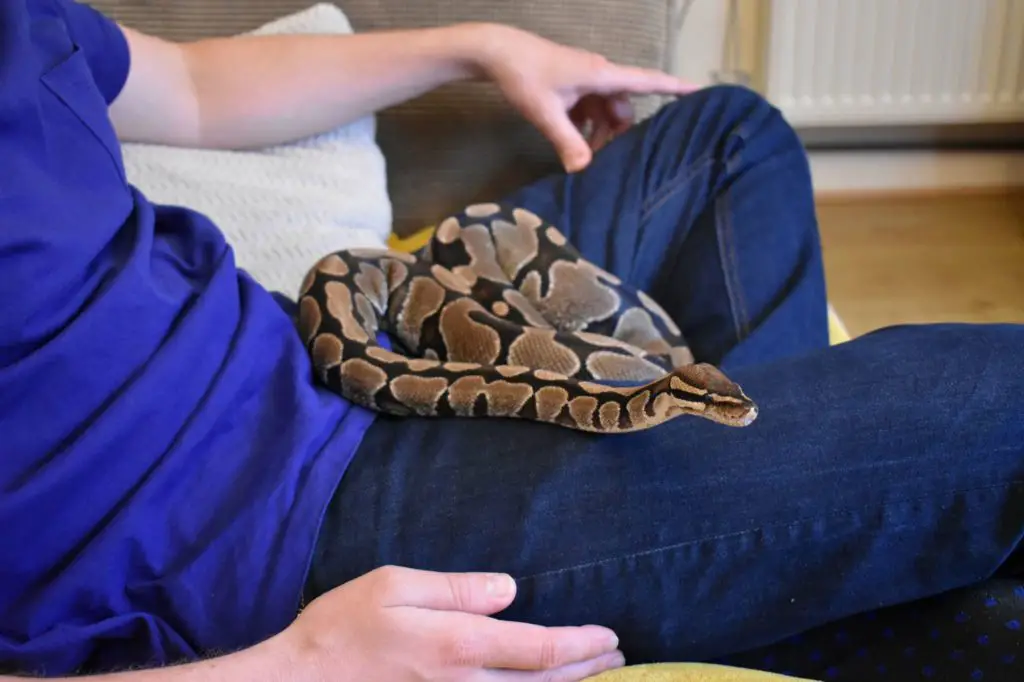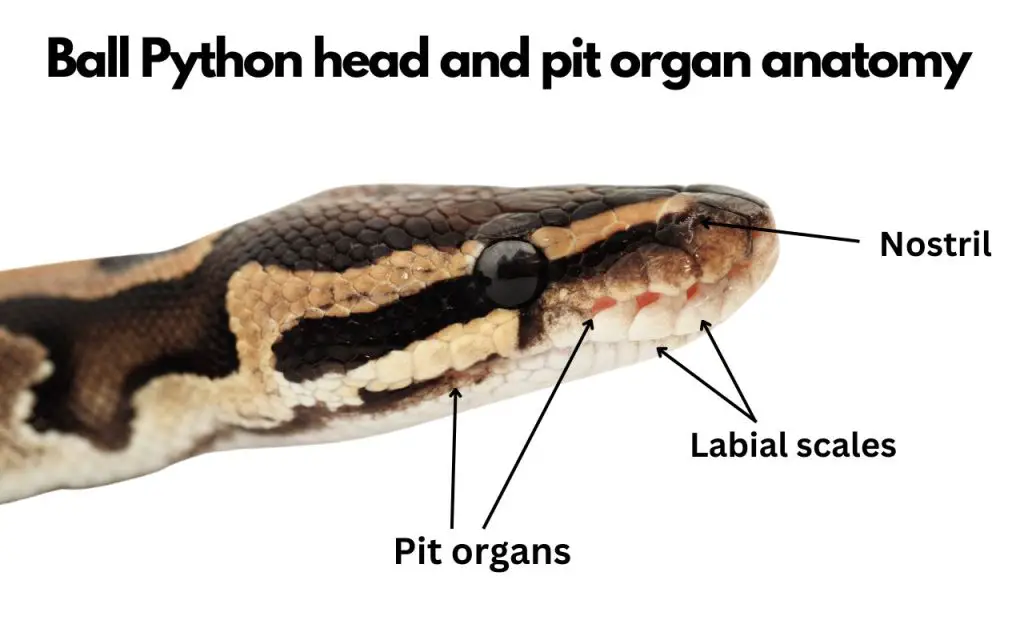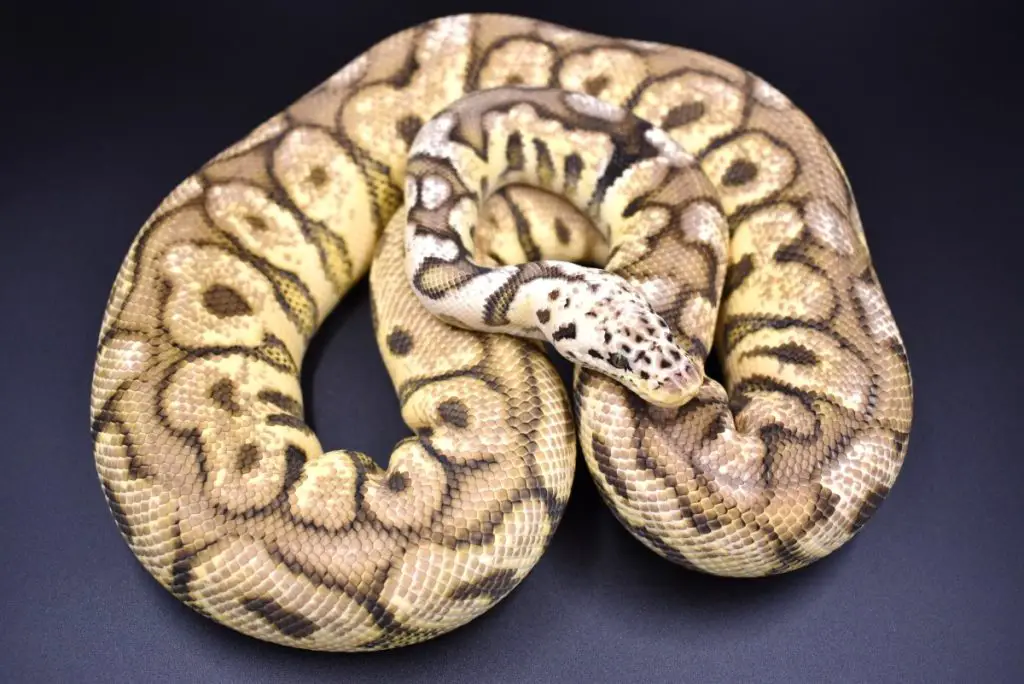Breeding and keeping Ball Pythons isn’t just a hobby for me; it’s a passion. Over the years, I’ve encountered a myriad of health issues that these beautiful creatures can face. Sometimes it was a mere blip, and at other times, it required immediate attention. Here, I delve deeper into the signs of a sick Ball Python and share my experiences and solutions.
Last updated on August 22nd, 2023 at 11:16 am
Signs of a Ball Python Dying
Nobody wants to see their beloved pet showing these signs. Truth be told, you can usually avoid all of them with good husbandry. Sometimes, however, a snake is already getting sick when you buy it!
Whatever the case may be, you need to recognise (and memorise) these signs if you intend to keep Ball Pythons long-term:
- Lethargy or lack of movement: If your snake has been unusually inactive for days, it’s a sign of distress.
- Loss of appetite: Refusing meals for periods of up to 3 months can be usual behavior for adults, but not juveniles. Baby Ball Pythons should be feeding every 5 to 7 days when you buy them. In general, you should consider fasting abnormal for any snake under 900-1000grams in weight.
- Breathing issues: Gasping, bubbling, wheezing, or irregular breathing indicates respiratory problems.
- Discoloration: A bluish tinge on their skin is normal during shedding. What is abnormal is when a snake just looks dull and lacklustre. A healthy python always have crisp, clean looking scales with a hint of iridescence.
- Vomiting or regurgition: Both of these behaviors are abnormal (please also see the full regurgitation article if you’re encountering this)

How to Check if a Ball Python is Healthy
A healthy Ball Python will give you a mix of both physical and behavioural signals to let you know it’s healthy. Often, sick snakes are lethargic, and you can tell something’s up. It doesn’t stop there, though.
Look for the following signs first:
- Eyes that sparkle: Bright, clear eyes are an indicator of health. Clouded eyes, unless the snake is shedding, suggest problems.
- Active tongue: A consistently flicking tongue indicates they’re exploring and interacting with their surroundings.
- Immaculate skin: It should be free from blemishes, spots, and rough patches. Their scales should be smooth and lie flat.
| Healthy Signs | Potential Problem Signs |
| Curiosity & exploration | Prolonged inactivity (extreme restlessness) |
| Regular feeding pattern | Repeatedly refusing food |
| Responsive to stimuli | Lack of response to touch |
| Regular shedding | Irregular or problematic shedding (dysecdysis) |
Check out my video below on how to give a new snake a physical examination. It only takes a couple of minutes, but can quickly help you spot any visible signs of illness:
Ball Python Respiratory Infection
This is such a common issue that it is probably the one you should be most on the lookout for. Far and away the biggest cause of an R.I. is temperature. So if you do have a case in your collection, I strongly recommend reviewing how you check your temperatures.
If you just a probe or analogue thermometer, then buy an infrared thermometer gun too to double check. Also, make sure you’re checking the temperature at the level your snake sleeps at, not just the ambient air temp.
Along with being potentially the most common Ball Python health issue, an RI is also the most urgent. By the time your snake shows symptoms, it may have a week or less to live. Getting to an exotics vet within 24-48hrs is vital.
Signs to look for include:
- Audible breathing: If you can hear your python breathe loudly, it’s a red flag.
- Mucus: Excessive mucus or a strange discharge from the mouth or nose is alarming. Bubbles may also be present.
- Open-mouth breathing: While cute in dogs, it’s problematic in pythons. It may be seen along with the snake raising the anterior third of its body off the ground.
Ball Python Mouth Rot
Mouth rot is nasty infection, but treatable. Also known as necrotic stomatitis, this condition is generally caused by a bacterial infection.
Whatever the causative agent may be, the underlying cause is almost always poor hygiene, low temperatures, or both.
Look for these signs:
- White residue: If you notice white, pus-like substances in the mouth, it’s indicative of stomatitis. These might form clumps of cheese-like material.
- Swollen or bleeding gums: A sure sign that all’s not well. Sometimes the gums don’t bleed all over, just in little pin-prick spots all over.
- Loss of appetite: Mouth rot can make feeding painful, leading to this symptom.
*More information: Ball Python mouth rot: symptoms, causese, and treatment

Ball Python Scale Rot
Also known as necrotic dermatitis, this disease is almost always a result of unsanitary conditions coupled with high humidity. Poor hygiene and damp conditions slowly degrade the exterior integument of the scales, and simultaneously weaken your snake’s immune system. Whilst scale rot is most often a bacterial infection, it can also be fungal.
The result is a spreading infection, which exhibits some of the following symptoms:
- Discolored scales: They may turn brown or even a painful red.
- Flaking scales: some scales lose their outer covering, and appear rough and wrinkly.
- Pink belly scales: pink patches can show up at the start of the infection, before the sores break out.
- Sores and pustules: these often form under a scale, before completely eating it away.
*More information: Ball Python Scale Rot: How to understand and treat it.
Ball Python Mites
A breeder’s nightmare, mites go literally everywhere. Yes, I’m aware that sentence rhymes – I did that because I really want you to remember it! If you hear about a pet shop, breeder, or anyone else who sells animals with mites then you shouldn’t give them the time of day. They are a pain to get rid of!
Snake mites are identifiable from the following clues:
- Visual confirmation: Mites are small but visible as black dots. Moreover, their dropping look like white dust on the snake’s scales.
- Behavioural changes: A snake trying to escape its skin will often soak more or rub against surfaces.
- Anaemia: this only occurs with a really bad infestation, where the mites are taking significant amounts of blood.
*More information: Ball Python mites: Identification and treatment.
Ball Python dehydration
Dehydration can be chronic or acute, and sometimes it’s already present when you buy a snake. Other times, it may happen if you consistently maintain humidity that is too low, or temperatures that are too high.
Unlike some of the other conditions in this article, you can often completely reverse dehydration yourself. You just need to act as soon as you notic any of the following signs:
- Wrinkled or loose skin: Gently pinch the skin; if it remains tented or doesn’t spring back quickly, it might be dehydrated.
- Dimpled eyes: Their eyes might appear to have lines, dimples, or creases on them. This occurs from sustained periods of low humidity.
- Reduced activity: A dehydrated snake often becomes lethargic.
- Difficulties in shedding: The snake might have patchy sheds or retain old skin.
*More information: Dehydration in Ball Pythons
How to Treat a Sick Snake
Don’t panic, but act:
- Consult a REPTILE veterinarian: They can provide targeted treatments.
- Quarantine the animal away from other pets.
- Sanitize their habitat: Remove potential sources of infection or pests.
- Check habitat parameters: Ensure the temperature and humidity levels are optimal.
The exact treatment for each illness is slightly different. Mites, for example, can occasionally be cured at home with a lot of hard work. An R.I., on the other hand, requires antibiotics and therefore a prescription – a vet is your animal’s best hope.

Can Snakes Get Sick from Humans?
SYes, albeit not directly. While common colds or flus aren’t transferable, other germs can be, and the most common way they get sick from us is when we handle other reptiles and transfer their germs. Viruses in particular are highly transmissible, and you should never handle different species of reptiles without washing your hands in-between.
Signs of a sick Ball Python: Final Thoughts…
Ball Pythons are resilient yet sensitive creatures. By staying observant and knowledgeable, we can ensure they live long, healthy lives. Never hesitate to seek professional advice when in doubt. A lot of the symptoms and illnesses I outline here sound scary, but don’t forget that over time you will get to know your snake’s habits.
Chances are that if you are a devoted keeper, you will notice any signs of illnesses early enough to take decisive action.

